One of Newmarket’s hidden gems, St Agnes’ Church in Bury Road was built to remember the lost love of a Duchess.
Viewed from atop Warren Hill, only a pencil-like spire punctuating the belt of trees which borders the Heath gives a clue to the existence of one of Newmarket’s hidden gems, a church built as a monument to love.
St Agnes’ Church, in Bury Road, was completed in 1886 by Caroline Agnes, Duchess of Montrose, a society hostess who entertained in Newmarket in the latter half of the 19th century and who defied convention at every turn.
The church which bears her name was built in memory of her second husband, William Stirling Crawfurd, generally known as Craw, who she had married in 1876 and who died while in Cannes in the south of France in the spring of 1883, aged 64.
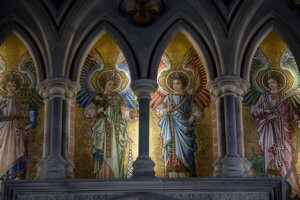
St Agnes Church Bury Road Newmarket Suffolk. Picture by Mark Westley
The Duchess was a great supporter of racing but because women of the time were not allowed to have horses running in their name, she used that of Mr Manton, probably because her then trainer, Alec Taylor, was based in Manton.
Her first marriage, when she was just 18, had been to the Duke of Montrose in 1836. Two years after he died in 1874 she married Crawfurd, the son of Waterloo hero, Sir Arthur Stirling, and a successful racehorse owner whose Sefton, trained by Taylor at Manton, won the 1878 Derby
As a couple they had horses with Joe Dawson at Bedford Lodge who, in the latter years of his life, suffered with chronic illness with the yard run by his wife Harriet and their head lad Richard ‘Buck’ Sherrard who, when Dawson died in 1880, became private trainer to Crawfurd and the Duchess when they turned the yard into their private stable.
The following year they won the 1,000 Guineas and the Oaks with Thebais, who remained in training as a four year old in 1882 and caused a near riot at the Rowley Mile that autumn when she had been heavily backed to win the Cambridgeshire and complete a notable double for Crawfurd, whose Corrie Roy had already won the Cesarewitch two weeks earlier.
But the day before the race, the Duchess insisted on the filly’s withdrawal, a decision which saw her booed and heckled by punters the day after the race, when Martini came into the winner’s enclosure after successfully carrying her husband’s colours. In fact, the Duchess knew her racing and had made the decision because she felt the heavily weight Thebais would have had no chance in the ground which had become holding due to particularly heavy rain that autumn.
At the end of that season the pair took their horses across the road to a stable she named Sefton Lodge after her husband’s Derby winner. They kept land close to their previous base as a stud which, when the Duchess died in 1894, was sold and became Stanley House, the private stables of the Earls of Derby.
Included in the deal were horses bred by the Duchess, not least Canterbury Pilgrim who, as well as winning the Oaks and the Jockey Club Cup, went on to be immensely influential at stud, producing seven winners including Chancer, who went on to sire the dam of Hyperion, and Swynford, sire of Classic winners Sansovino, Tranquil, Keysoe, Ferry and Bettina, and champion sire Blandford whose Classic winners included Triple Crown winner Bahram and Derby winner Blenheim. Sadly, Crawfurd did not live much beyond the move.
When his body was brought back from France it was initially buried on the Sefton Lodge estate before later being reinterred behind the easterly end of the church built by his grief stricken widow. When she died in 1894 she was laid to rest beside him.
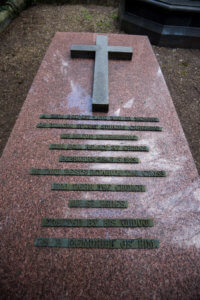
St Agnes Church Bury Road Newmarket Suffolk. Picture by Mark Westley
The Duchess was a larger than life character and a cartoonist’s dream. With her ample figure, which gave rise to the rather unkind nickname, Six Mile Bottom, her shock of red hair, usually topped by a man’s Homburg hat, and her booming voice, she was once referred to as the Duchess of Billingsgate as a result of her less than lady-like language.
Later, she was said to have developed an infatuation for jockey Fred Archer whose fame and brooding good looks had made him something of a Victorian heart throb. But as the legendary rider’s physical health was failing as a result of the constant wasting he put his frail body through, it was the Duchess whose demands possibly hastened his tragic demise when she expected Archer to make the 8st 6lbs weight alloted to her Derby third St Mirrin in the Cambridgeshire.
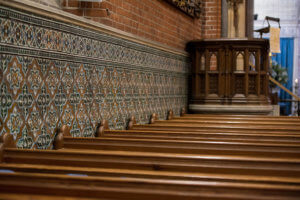
St Agnes Church Bury Road Newmarket Suffolk. Picture by Mark Westley
Archer now 29 was already struggling to do anything below nine stone and for three days before the race ate nothing and drank only the terrible purgative Archer’s Mixture.
He eventually weighed in at 8st 7lbs, a pound overweight and lost the race by a head to a horse carrying a stone less. The defeat, along with many other demons, haunted him and a month later he was dead, shooting himself in his palatial home in Snailwell Road the year after St Agnes’ Church was completed and opened to the public.
Designed by R H Carpenter, it was then situated in the parish of Exning and was consecrated by Lord Alwyne Compton, Bishop of Ely, on October 8, 1887, the very same week Fred Archer’s house and contents was put up for auction.
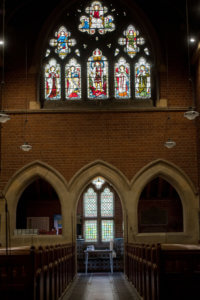
St Agnes Church Bury Road Newmarket Suffolk. Picture by Mark Westley
The service report in the Newmarket Journal, sister title to Suffolk News, described the building as ‘a handsome little church still bedecked with arrangements in place from the previous week’s harvest festival celebration’.
In her role as its patroness, the Duchess presented the Rev Alfred Sharpe to the bishop as the first vicar, but he was soon replaced in 1888 by the Rev William Colville-Wallis who, on one occasion, made the mistake of praying for fine weather to assist the harvest after a very wet summer.
What he did not know was that the Duchess had a horse running in the St Leger which was particularly suited to soft ground.
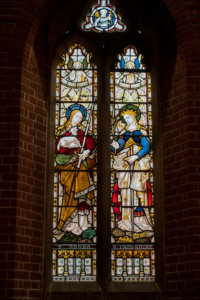
St Agnes Church Bury Road Newmarket Suffolk. Picture by Mark Westley
The Duchess took exception to the sermon and stormed out, threatening to not allow Wallis to preach in her church again. But the storm blew over when he apologised and he remained vicar until 1935 and was buried at St Agnes’. St Agnes’ remained as an independent parish until 1966 when it was finally amalgamated, after some resistence, with neighbouring St Mary’s.
A Grade II listed building, it is said to have the most opulent 19th century interior in Suffolk, with a dado of majolica tiling throughout the nave and chapel believed to be the work of the celebrated tile maker Frederick Garrard at his Millwall pottery in east London.
At the east end is a mosaic by Salviati, glassmakers and mosaicists based on the island of Murano near Venice, whose Murano glass work is still world famous. They had offices in London’s Regent Street and their work in the capital included the Albert Memorial.
Over the church’s alter is a marble reredos by the medallist and sculptor Sir Joseph Edgar Boehm, best known for the Jubilee head of Queen Victoria on coinage and the statue of the Duke of Wellington at Hyde Park Corner in London.
The organ was designed by Sir Arthur Sullivan, of Gilbert and Sullivan fame, whose love of racing meant he was a frequent visitor to Newmarket, and built by Henry Jones who often worked with the composer.
All the stained glass in the church is by Clayton and Bell, one of the most prolific and proficient English workshops of stained glass during the latter half of the 19th century and the early 20th century.
At the time they were commissioned by the Duchess they held a royal warrant from Queen Victoria. Among their extensive portfolio of work is the West Window of King’s College Chapel, in Cambridge, while another significant commission was to design the mosaics for each side, and beneath the canopy, of the Albert Memorial.
Because they worked closely with Salviati, which manufactured mosaics to Clayton and Bell’s designs, it is possible they installed the mosaics at St Agnes’.
Among the saints depicted in the church’s windows are St Etheldreda, the founder of Ely Abbey upon whose site Ely Cathedral was built, and who was born in Exning, and St Agnes, the patron saint of virgins, young girls and engaged couples.
And because of its situation the church has hosted the nuptials of some of racing’s most famous, from Classic winning jockeys like Fred Lester Rickaby – uncle of Lester Piggott – to trainer Sir Henry Cecil, whose funeral service was also held there before he was taken to his family’s seat in Scotland for burial.
Details of how you can visit St Agnes Church can be found here.
This fascinating story was written by Alison Hayes, editor of Newmarket Journal. Thank you Alison for allowing us to share.

08/04/2024
Discover Newmarket Enters New Partnership with National Horseracing Museum
Discover Newmarket will manage Visitor Services on behalf of the National Horseracing Museum in an exciting new partnership agreed last week.
18/03/2024
The Story of The Tin Man
Retiring as a living legend at the National Stud
Since arriving at the National Stud in April 2022, this retired legend is most definitely a firm favourite amongst our tour attendees.
06/03/2024
Easter Activities in and around Newmarket
With Easter just around the corner, there’s the promise of warmer weather and the chance to celebrate over the long weekend, is in sight.
29/02/2024
Time called for long-standing employee, Alan Grimwood, at Corney and Barrow
Alan is a familiar face to many in and around Newmarket as he drives the Corney and Barrow branded, red van delivering wines and spirits.
19/02/2024
Ely Cathedral: A Celebration of Bridal Gowns Exhibition
Just a stones throw away from Newmarket, Ely Cathedral is highly regarded by historians and architects from all over the world for its beauty and size.
31/01/2024
Your Guide to making Valentine’s Day Special
Show them how much they’re loved, with our special Valentine’s Day Guide.
Visit East of England and see where they became Master of the Air!
18/01/2024
Become a Tour Guide with Discover Newmarket
Discover Newmarket is the official tourism body for Newmarket and the surrounding area, responsible for promoting Newmarket as a key destination for the East of England.



